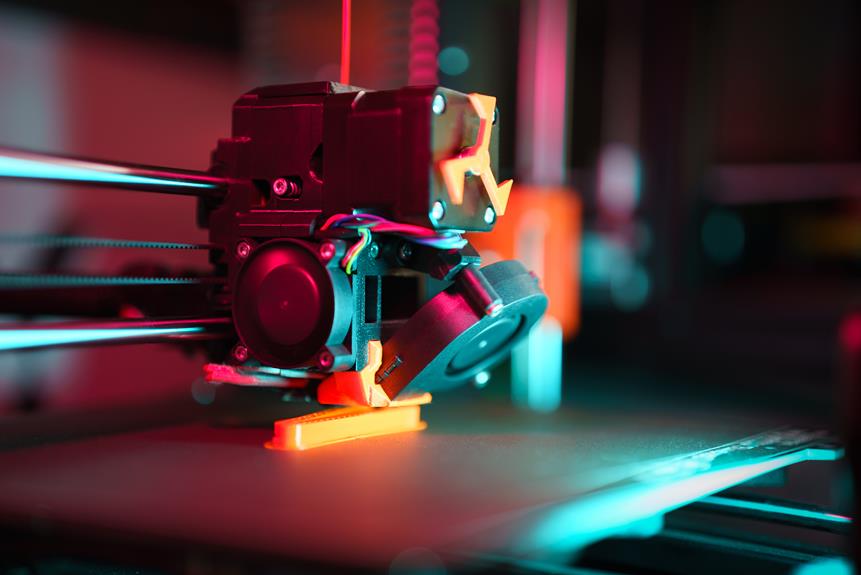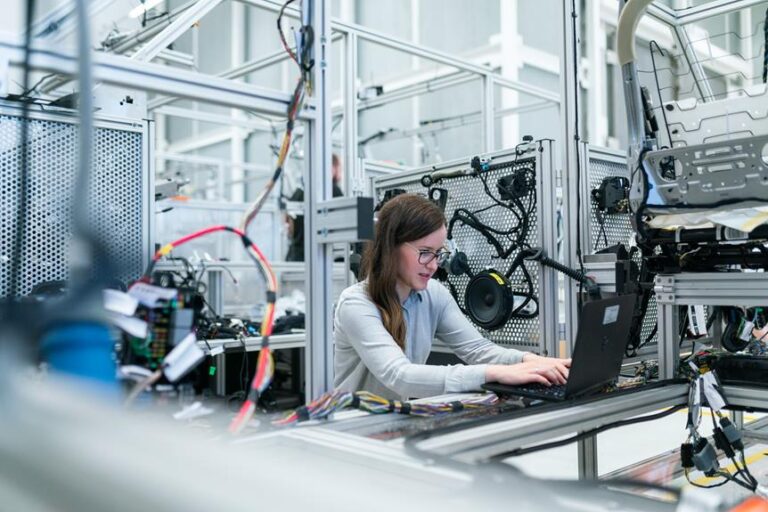SLS 3D Printers: Empowering Design Possibilities With Selective Laser Sintering
With the rapid advancements in 3D printing technology, designers now have the power to bring their wildest creations to life. Selective Laser Sintering (SLS) 3D printers have emerged as a game-changer, offering unparalleled design possibilities.
In fact, SLS 3D printing has revolutionized the prototyping process, allowing designers to iterate and refine their concepts with ease. This article explores the limitless potential of SLS 3D printing technology, delving into its advantages, applications, and the creative freedom it offers to designers and manufacturers alike.
Key Takeaways
- SLS 3D printing revolutionizes prototyping and functional part creation.
- SLS offers unparalleled design possibilities and versatility.
- SLS enables the creation of complex geometries and intricate designs.
- SLS allows for rapid prototyping, reducing time and cost.
3D Printing With Selective Laser Sintering: a Game-Changer for Designers
The use of selective laser sintering (SLS) in 3D printing has become a game-changer for designers. SLS 3D printers have revolutionized the way designers create prototypes and functional parts, offering unprecedented freedom and versatility. Selective laser sintering is a technique that involves using a high-powered laser to fuse powdered materials together layer by layer, resulting in highly detailed and intricate objects.
One of the key advantages of SLS 3D printers is their ability to work with a wide range of materials, including plastics, metals, and even ceramics. This versatility allows designers to explore different possibilities and experiment with various materials to achieve the desired properties and aesthetics in their designs.
Moreover, the selective laser sintering process enables complex geometries and intricate designs that would be challenging or impossible to achieve using traditional manufacturing methods. The layer-by-layer approach allows for the creation of intricate internal structures, such as lattice patterns and honeycomb-like structures, which can enhance the strength and lightweight properties of the final product.
Furthermore, SLS 3D printers offer designers the freedom to iterate and make design modifications easily and quickly. Unlike traditional manufacturing methods, which often involve expensive and time-consuming tooling changes, SLS allows for rapid prototyping and design iterations, saving both time and cost.
The Advantages of SLS 3D Printing in the Prototyping Process
SLS 3D Printing offers numerous advantages in the prototyping process, providing designers with enhanced flexibility and efficiency. One of the key advantages of SLS printing is its ability to create complex geometries and intricate designs that would be difficult or impossible to achieve using traditional manufacturing methods. The laser sintering technology allows for the precise fusion of powdered materials, layer by layer, resulting in highly detailed and accurate prototypes.
Another advantage of SLS 3D printing is its versatility in material selection. Unlike other 3D printing technologies that are limited to specific materials, SLS printers can work with a wide range of materials, including plastics, metals, and even composites. This allows designers to choose the most suitable material for their specific application, whether it's for testing functionality, evaluating form and fit, or simulating end-use conditions.
Furthermore, SLS printing offers a faster turnaround time compared to traditional prototyping methods. With SLS technology, designers can quickly iterate and refine their designs, making it easier to meet tight deadlines and bring products to market faster.
In addition, SLS 3D printers enable designers to create prototypes with superior strength and durability. The laser sintering process produces parts with excellent mechanical properties, making them suitable for functional testing and validation.
Breaking Barriers: Unleashing Creativity With SLS 3D Printing
By combining advanced technology with limitless design possibilities, SLS 3D printing opens up a new realm of creativity and innovation for designers and manufacturers. With its ability to print complex geometries and intricate details, SLS 3D printing empowers designers to break free from the constraints of traditional manufacturing methods and explore uncharted territories of design.
One of the key advantages of SLS 3D printing is its ability to create intricate and lightweight structures that were previously impossible to achieve. By selectively fusing powdered materials layer by layer using a high-powered laser, SLS 3D printers can produce intricate designs with minimal material wastage. This allows designers to create lightweight and strong parts, opening up possibilities for applications in aerospace, automotive, and other industries that demand high-performance components.
To further illustrate the creative potential of SLS 3D printing, consider the following table showcasing some of the design features and benefits it offers:
| Design Features | Benefits |
|---|---|
| Complex geometries | Enables the creation of intricate designs that were previously impossible to manufacture. |
| Internal cavities | Allows for the integration of hidden features and complex internal structures. |
| Interlocking parts | Facilitates the assembly of complex systems without the need for additional fasteners. |
| Customization | Enables the production of unique and personalized products tailored to individual needs. |
| Prototyping iterations | Speeds up the design iteration process, allowing for faster product development and refinement. |
With SLS 3D printing, designers and manufacturers have the freedom to push the boundaries of what is possible, unleashing their creativity and bringing innovative ideas to life. Whether it's creating complex architectural models or producing functional prototypes, SLS 3D printing offers a world of design possibilities that were once unimaginable.
From Concept to Reality: How SLS 3D Printers Transform Manufacturing
With its ability to seamlessly transition from conceptualization to production, SLS 3D printers revolutionize the manufacturing process by enabling the transformation of ideas into tangible products. Here are four ways in which SLS 3D printers transform manufacturing:
- Rapid Prototyping: SLS 3D printers allow designers and engineers to quickly create prototypes of their designs, reducing the time and cost associated with traditional prototyping methods. This enables faster iterations and improvements in product development.
- Complex Geometries: SLS 3D printers excel at producing complex geometries that are difficult or impossible to manufacture using traditional methods. This opens up new design possibilities and allows for the creation of intricate and customized products.
- Material Versatility: SLS 3D printers are compatible with a wide range of materials, including plastics, metals, and ceramics. This versatility allows manufacturers to choose the most suitable material for their specific application, resulting in products with enhanced performance and functionality.
- Cost Efficiency: By eliminating the need for molds, tools, and assembly processes, SLS 3D printing reduces production costs. It also minimizes material waste, as only the required amount of material is used in the printing process. This makes SLS 3D printing a cost-effective solution for small production runs and custom manufacturing.
With these transformative capabilities, SLS 3D printers empower manufacturers to bring their ideas to life in ways that were previously unimaginable. The next section will explore the limitless possibilities of SLS 3D printing technology and its impact on various industries.
Exploring the Limitless Possibilities of SLS 3D Printing Technology
The emergence of SLS 3D printing technology has opened up a world of boundless opportunities for design innovation and manufacturing advancements. With its ability to create complex geometries and intricate details, SLS 3D printing enables designers and engineers to explore new frontiers in product development. From aerospace components to medical implants, SLS 3D printing offers a level of design freedom that was previously unimaginable.
One of the key advantages of SLS 3D printing is its ability to produce functional prototypes and end-use parts directly from digital files. This eliminates the need for costly and time-consuming tooling processes, allowing for faster iteration and product development cycles. Additionally, the versatility of SLS 3D printing materials, such as nylon, opens up endless possibilities for customization and material selection.
Another exciting aspect of SLS 3D printing is its ability to create lightweight and durable parts with complex internal structures. This makes it ideal for applications in industries such as automotive, where weight reduction and performance optimization are critical. SLS 3D printing also allows for the integration of multiple components into a single printed part, reducing assembly time and complexity.
Frequently Asked Questions
What Are the Main Differences Between SLS 3D Printing and Other 3D Printing Technologies?
SLS 3D printing, compared to other technologies, utilizes a process called selective laser sintering to fuse powdered materials together. This method enables the creation of complex geometries, functional prototypes, and end-use parts with high precision and durability.
What Materials Can Be Used in SLS 3D Printing?
SLS 3D printing utilizes a range of materials, including thermoplastics, metals, ceramics, and composites. These materials are transformed into functional and intricate designs through the process of selective laser sintering, enabling limitless possibilities in design and manufacturing.
Are SLS 3D Printers Suitable for Large-Scale Manufacturing?
Yes, SLS 3D printers are suitable for large-scale manufacturing due to their ability to produce complex and durable parts with a wide range of materials, high precision, and minimal post-processing requirements.
How Does the Cost of SLS 3D Printing Compare to Other Manufacturing Methods?
The cost of SLS 3D printing compared to other manufacturing methods should be evaluated based on factors such as production volume, material selection, and equipment maintenance. It is important to consider the specific requirements of each manufacturing process to determine their respective cost effectiveness.
What Are the Limitations or Challenges of Using SLS 3D Printing Technology?
The limitations and challenges of using SLS 3D printing technology include high initial costs, limited material options, post-processing requirements, and the need for skilled operators. These factors can impact the accessibility and scalability of the technology.
Conclusion
In conclusion, SLS 3D printing technology revolutionizes the design and manufacturing processes, offering unparalleled opportunities for creativity and innovation.
This game-changing technology empowers designers to break barriers and unleash their imagination, transforming concepts into reality.
With its advantages in prototyping and manufacturing, SLS 3D printers open up limitless possibilities for the future of design.
Embracing this cutting-edge technology, designers can explore new frontiers and push the boundaries of what is possible in the world of manufacturing.









